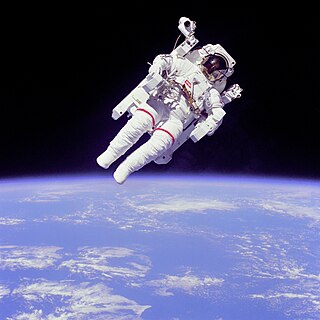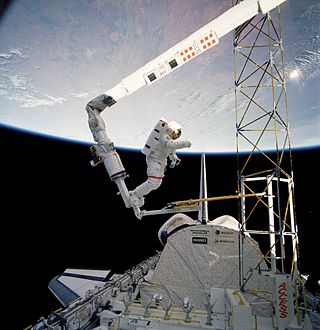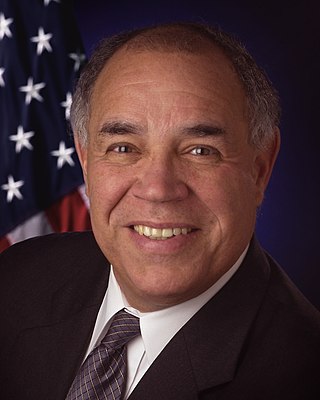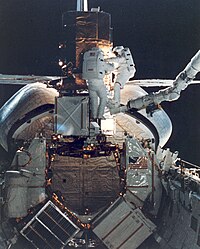
STS-6 was the sixth NASA Space Shuttle mission and the maiden flight of the Space ShuttleChallenger. Launched from Kennedy Space Center on April 4, 1983, the mission deployed the first Tracking and Data Relay Satellite, TDRS-1, into orbit, before landing at Edwards Air Force Base on April 9, 1983. STS-6 was the first Space Shuttle mission during which a Extravehicular activity was conducted, and hence was the first in which the Extravehicular Mobility Unit (EMU) was used.

John Howard Casper is a former American astronaut and retired United States Air Force pilot.

The Manned Maneuvering Unit (MMU) is an astronaut propulsion unit that was used by NASA on three Space Shuttle missions in 1984. The MMU allowed the astronauts to perform untethered extravehicular spacewalks at a distance from the shuttle. The MMU was used in practice to retrieve a pair of faulty communications satellites, Westar VI and Palapa B2. Following the third mission the unit was retired from use. A smaller successor, the Simplified Aid For EVA Rescue (SAFER), was first flown in 1994, and is intended for emergency use only.

STS-41-C was NASA's eleventh Space Shuttle mission, and the fifth mission of Space Shuttle Challenger. The launch, which took place on April 6, 1984, marked the first direct ascent trajectory for a Space Shuttle mission. During the mission, Challenger's crew captured and repaired the malfunctioning Solar Maximum Mission satellite, and deployed the Long Duration Exposure Facility (LDEF) experimental apparatus. STS-41-C was extended one day due to problems capturing the Solar Max satellite, and the landing on April 13, 1984, took place at Edwards Air Force Base, instead of at Kennedy Space Center as had been planned. The flight was originally numbered STS-13.

STS-41-B was NASA's tenth Space Shuttle mission and the fourth flight of the Space ShuttleChallenger. It launched on February 3, 1984 and landed on February 11, 1984, after deploying two communications satellites. It was also notable for including the first untethered spacewalk.

STS-61-B was the 23rd NASA Space Shuttle mission, and its second using Space Shuttle Atlantis. The shuttle was launched from Kennedy Space Center, Florida, on November 26, 1985. During STS-61-B, the shuttle crew deployed three communications satellites, and tested techniques of constructing structures in orbit. Atlantis landed at Edwards Air Force Base, California, at 16:33:49 EST on December 3, 1985, after 6 days, 21 hours, 4 minutes, and 49 seconds in orbit.

STS-37, the thirty-ninth NASA Space Shuttle mission and the eighth flight of the Space Shuttle Atlantis, was a six-day mission with the primary objective of launching the Compton Gamma Ray Observatory (CGRO), the second of the Great Observatories program which included the visible-spectrum Hubble Space Telescope (HST), the Chandra X-ray Observatory (CXO) and the infrared Spitzer Space Telescope. The mission also featured two spacewalks, the first since 1985.

STS-49 was NASA's maiden flight of the Space Shuttle Endeavour, which launched on May 7, 1992. The primary goal of its nine-day mission was to retrieve an Intelsat VI satellite, Intelsat 603, which failed to leave Low Earth orbit two years before, attach it to a new upper stage, and relaunch it to its intended geosynchronous orbit. After several attempts, the capture was completed with the only three-person extravehicular activity (EVA) in space flight history. It would also stand until STS-102 in 2001 as the longest EVA ever undertaken.

Steven Alan Hawley is a former NASA astronaut who flew on five U.S. Space Shuttle flights. He is professor of physics and astronomy and director of engineering physics at the University of Kansas.

Claude Nicollier is the first astronaut from Switzerland. He has flown on four Space Shuttle missions. His first spaceflight (STS-46) was in 1992, and his final spaceflight (STS-103) was in 1999. He took part in two servicing missions to the Hubble Space Telescope. During his final spaceflight he participated in a spacewalk, becoming the first European Space Agency astronaut to do so during a Space Shuttle mission. In 2000 he was assigned to the Astronaut Office Extravehicular Activity Branch, while maintaining a position as Lead ESA Astronaut in Houston. Nicollier retired from ESA in April 2007.

Robert Lee Stewart is an American retired military officer and NASA astronaut who was a brigadier general of the United States Army.

James Dougal Adrianus "Ox" van Hoften is an American civil and hydraulic engineer, retired U.S. Navy officer and aviator, and a former astronaut for NASA.

Terry Jonathan "T. J." Hart is an American mechanical and electrical engineer, a retired United States Air Force lieutenant colonel and pilot, and former NASA astronaut. Hart served as a mission specialist on the STS-41-C mission, where tasks included operation of the shuttle Remote Manipulator System (RMS) arm to deploy the Long Duration Exposure Facility (LDEF) and Solar Max satellite.

Jeffrey Alan Hoffman is an American former NASA astronaut and currently a professor of aeronautics and astronautics at MIT.

John Mace Grunsfeld is an American physicist and a former NASA astronaut. He is a veteran of five Space Shuttle flights and has served as NASA Chief Scientist. His academic background includes research in high energy astrophysics, cosmic ray physics and the emerging field of exoplanet studies with specific interest in future astronomical instrumentation. After retiring from NASA in 2009, he served as the deputy director of the Space Telescope Science Institute in Baltimore, Maryland. In January 2012, he returned to NASA and served as associate administrator of NASA's Science Mission Directorate (SMD). Grunsfeld announced his retirement from NASA in April 2016.

Frederick Drew Gregory is a former United States Air Force pilot, military engineer, test pilot, and NASA astronaut as well as former NASA Deputy Administrator. He also served briefly as NASA Acting Administrator in early 2005, covering the period between the departure of Sean O'Keefe and the swearing in of Michael D. Griffin.

Gregory Jordan "Greg" Harbaugh is an aeronautical/astronautical engineer and former NASA astronaut. He flew on four space shuttle missions as a mission specialist with responsibilities that included Remote Manipulator System (RMS) operation and Extravehicular Activity (EVAs). He performed three spacewalks during the shuttle missions including in support of repair/refurbishment of the Hubble Space Telescope.

George David Low was an American aerospace executive and a NASA astronaut. With undergraduate degrees in physics and mechanical engineering and a master's degree in aeronautics and astronautics, he worked in the Jet Propulsion Laboratory (JPL) at the California Institute of Technology in the early 80's, before being picked as an astronaut candidate by NASA in 1984. In addition to holding some technical assignments, he logged more than 700 hours in space, before he left NASA in 1996 to pursue a career in the private sector. He was the son of George M. Low, the manager of the Apollo Spacecraft Program Office, and later, the 14th president of Rensselaer Polytechnic Institute.

Carl Erwin Walz is a retired NASA astronaut currently working for Orbital Sciences Corporation's Advanced Programs Group as vice president for Human Space Flight Operations. Walz was formerly assigned to the Exploration Systems Mission Directorate at NASA Headquarters in Washington, D.C. He was the Acting Director for the Advanced Capabilities Division in the Exploration Systems Mission Directorate, and was responsible for a broad range of activities to include Human Research, Technology Development, Nuclear Power and Propulsion and the Lunar Robotic Exploration Programs to support the Vision for Space Exploration.

William Frederick Fisher is an American physician and a former NASA astronaut. Fisher went into space in 1985 on board the Space Shuttle. He retired from NASA in 1992 and returned to the full-time practice of medicine. His time at NASA coincided with that of his former wife and fellow astronaut Anna Lee Fisher. He is also the great grandson of Pony Express rider William Frederick Fisher






















